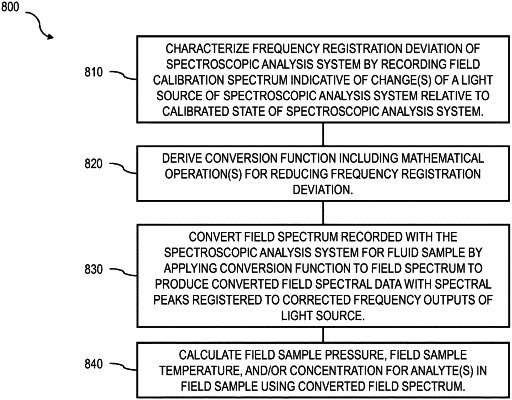| CPC G01N 21/274 (2013.01) [G01J 3/0297 (2013.01); G01J 3/28 (2013.01); G01J 3/42 (2013.01); G01J 3/457 (2013.01); G01N 21/39 (2013.01); G01J 2003/423 (2013.01); G01N 21/211 (2013.01); G01N 21/35 (2013.01); G01N 21/3504 (2013.01); G01N 21/359 (2013.01); G01N 2021/3595 (2013.01); G01N 2021/399 (2013.01)] | 20 Claims |

|
1. A method comprising:
providing a tunable diode laser absorption spectroscopic analysis system comprising:
a frequency-scannable laser light source configured to emit light over a desired range of frequencies;
a measurement volume containing a sample fluid and arranged such that light from the light source selectively passes through the measurement volume;
a detector configured to receive the light from the light source and to quantify the received light; and
a wavelength/frequency calibrator arranged such that light from the light source selectively passes therethrough and configured to generate individually resolvable frequency markers, which define a frequency scale within the range of frequencies when the light from the light source passes therethrough;
characterizing a current frequency registration deviation of the spectroscopic analysis system, the characterizing comprising recording a field calibration spectrum, which is generated by passing the light from the light source through the wavelength/frequency calibrator to the detector, wherein the field calibration spectrum is indicative of one or more changes of the light source relative to a stored calibrated state of the spectroscopic analysis system;
deriving a conversion function comprising at least one mathematical operation that reduces the current frequency registration deviation relative to the stored calibrated state, wherein the conversion function comprises a fitted mathematical expression to model a relative frequency difference between spectral features present in the field calibration spectrum and the frequency markers provided by the wavelength/frequency calibrator such that the characterized current frequency registration deviation is consistent with a stored calibrated frequency registration deviation of the spectroscopic analysis system characterized when the spectroscopic analysis system was in the stored calibrated state,
wherein the spectral features present in the field calibration spectrum include peaks and/or valleys of one or more of an intensity change, a frequency modulation amplitude, a frequency modulation profile and a frequency modulation phase delay resulting from interaction of the emitted light from the light source with the wavelength/frequency calibrator, as provided by the field calibration spectrum, relative to one or more of an intensity change, frequency modulation amplitude, a frequency modulation profile and a frequency modulation phase delay, respectively, resulting from interaction of light from the light source with the wavelength/frequency calibrator in the stored calibrated state;
converting a field spectrum recorded with the spectroscopic analysis system for a field sample comprising the sample fluid, the field spectrum generated by passing the light from the light source through the measurement volume, wherein the converting comprises applying the conversion function to the field spectrum to produce converted field spectral data comprising spectral data registered to a corrected frequency response of the spectroscopic analysis system, wherein the field spectrum is converted to the frequency scale provided by the wavelength/frequency calibrator such that spectral features of the field spectrum are correctly registered to a same frequency as in the stored calibrated state; and
calculating one or more of a pressure of the field sample, a temperature of the field sample, and a concentration for one or more analytes in the field sample using the converted field spectral data.
|